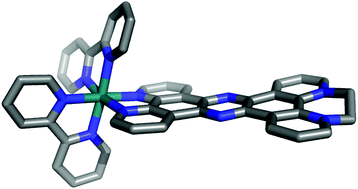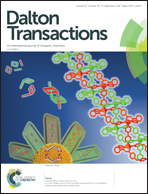Turning intercalators into groove binders: synthesis, photophysics and DNA binding properties of tetracationic mononuclear ruthenium(ii)-based chromophore–quencher complexes†
Abstract
The synthesis of two new tetracationic mononuclear RuII complexes containing the tetrapyridyl [3,2-a:2′,3′-c:3′′,2′′-h:2′′′,3′′′-j] phenazine ligand in which the uncoordinated site has been converted into a dicationic ethylene-bipyridyldiylium unit is reported. The structure of the complexes is fully assigned through detailed NMR studies and, in one case, through an X-ray crystallography study. Voltammetry, optical spectroscopy and computational studies confirm that the bipyridyldiylium moiety has a low-lying reduction that quenches the 3MLCT-based emission usually observed in such systems. The new complexes interact with DNA in a quite different manner to their dicationic analogues: they both bind to duplex DNA with micromolar affinity through groove binding. These observations are rationalized through a consideration of their structural and electronic properties.



 Please wait while we load your content...
Please wait while we load your content...